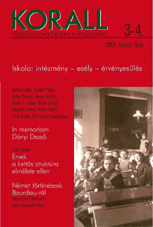A középiskoláztatás stratégiái. A pozsonyi középiskolák társadalomtörténete a 19. század első felében
Secondary schooling strategies. The social history of the secondary schools of Pozsony in the first half of the 19t h century
Author(s): Árpád TóthSubject(s): History
Published by: KORALL Társadalomtörténeti Egyesület
Keywords: social history; social history of education; secondary schools; 19th century; Hungary; Pozsony (Bratislava; Slovakia); urban society and education
Summary/Abstract: Combining macro statistical, quantitative techniques and prosopographical methods, the article examines the "demand side" of the secondary schools in Pressburg (Pozsony), one of the major schooling towns in Hungary in the first half of the 19th century. Having lost its national central institutions in the 1780s, attacked directly by the French troops during the French Wars and affected badly by the prosperous economy of the nearby metropolis Vienna, the town (now Bratislava, the capital of Slovakia) was a stagnating provincial centre in that time Hungary. One of its social characteristics was the presence of a large number of students in grammar schools and higher education (law and theology), both for Catholic and Protestant (Lutheran) people. The article reveals that during the five decades as a whole only Lutheran higher education increased in terms of the number of the students enrolled. The growth of all other parts of education turned into decrease after the renewal of the Hungarian Parliamentary sessions in Pressburg in 1825 (after a 13-year-long period of absolutistic government), probably due to the rising prices and the worsening life conditions in town. In general, all schools recruited their students from a fairly large area, but Lutheran schooling attracted more students than its Catholic counterpart from outside the town and from churches different from its own. During the period of growth in Pressburg schools a trend of "democratisation" went on in terms of the origin of students resulting in a fall in the proportion of noble and an increase in that of bourgeois, or rather "burgher", origin, but this trend stopped and returned after about 1825. The higher rate of bürgerliche students among Lutherans may reflect the differences in social structure between the two denominations but it also accompanies a tendency of finishing more classes of school among Protestants which can be attributed to different strategies of the use of schooling. The analysis of students from Lutheran Pressburg-born burgher families shows the general presence of a model of a diversified strategy which directed sons within the same families to different positions in society, and the related level of schooling, from artisan and merchant trades to the high professions.
Journal: Korall - Társadalomtörténeti folyóirat
- Issue Year: 2001
- Issue No: 3-4
- Page Range: 70-103
- Page Count: 34
- Language: Hungarian

